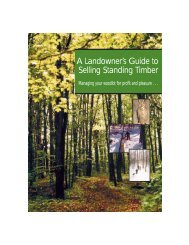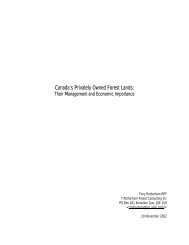A land manager's guide to conserving habitat for forest birds in ...
A land manager's guide to conserving habitat for forest birds in ...
A land manager's guide to conserving habitat for forest birds in ...
Create successful ePaper yourself
Turn your PDF publications into a flip-book with our unique Google optimized e-Paper software.
European Starl<strong>in</strong>gs—Pho<strong>to</strong>: J. Fuhrman/VIREO<br />
Landscape Composition<br />
The <strong>habitat</strong> quality of a <strong>for</strong>est patch needs <strong>to</strong> be considered <strong>in</strong> a<br />
<strong>land</strong>scape context. For <strong>in</strong>stance, the value of a 50 ha <strong>for</strong>est<br />
fragment <strong>in</strong> provid<strong>in</strong>g <strong>habitat</strong> <strong>for</strong> area sensitive <strong>birds</strong> depends<br />
considerably on the amount of regional <strong>for</strong>est cover. A large <strong>for</strong>est<br />
patch may be more important <strong>in</strong> a heavily fragmented <strong>land</strong>scape<br />
where it is the only <strong>for</strong>est patch <strong>in</strong> which <strong>birds</strong> are able <strong>to</strong> survive<br />
and reproduce, compared <strong>to</strong> an extensively <strong>for</strong>ested region where<br />
it is one of many. Bird populations do not exist <strong>in</strong> isolation.<br />
Effective management h<strong>in</strong>ges on consider<strong>in</strong>g the composition of<br />
the surround<strong>in</strong>g <strong>land</strong>scape as well as the patch itself. A rich<br />
<strong>land</strong>scape will have a diversity of <strong>habitat</strong> types at a variety of<br />
successional stages <strong>in</strong>clud<strong>in</strong>g: old growth <strong>for</strong>est, deep <strong>in</strong>terior<br />
<strong>for</strong>est, mid-successional <strong>for</strong>est, and early successional <strong>for</strong>est.<br />
Ultimately, such a <strong>land</strong>scape would have the greatest potential <strong>to</strong><br />
support the greatest diversity of species.<br />
Urban Sprawl and Urbanization<br />
Another major process affect<strong>in</strong>g <strong>for</strong>ests of southern Ontario is<br />
urbanization, which <strong>in</strong>cludes the expansion and sprawl of cities,<br />
<strong>to</strong>wns, and villages and the trend <strong>to</strong>wards rural liv<strong>in</strong>g. This often<br />
entails the construction of subdivisions and <strong>in</strong>dividual homes<br />
with<strong>in</strong> or adjacent <strong>to</strong> woodlots. Urbanization is particularly<br />
damag<strong>in</strong>g <strong>to</strong> natural <strong>land</strong>scapes because the conversion from a<br />
<strong>for</strong>est <strong>to</strong> an urban environment of pavement and build<strong>in</strong>gs is not<br />
only permanent but is occurr<strong>in</strong>g on a large scale. Urban sprawl<br />
results <strong>in</strong> <strong>habitat</strong> loss and fragmentation, as well as numerous<br />
human <strong>in</strong>duced stressors that are either exclusive <strong>to</strong>, or greatly<br />
amplified <strong>in</strong> urban areas. When we look at the urban gradient we<br />
see changes <strong>in</strong> species composition, diversity, and abundance.<br />
The changes that occur at the urbanized end are those associated<br />
with a loss of bird species <strong>in</strong> the region as well as a decrease <strong>in</strong><br />
the ability of the <strong>for</strong>est <strong>to</strong> per<strong>for</strong>m some functions, like clean<strong>in</strong>g<br />
Typical Southern Ontario Landscape<br />
Artwork: Peter Burke<br />
30 The Fragmented Forest

















